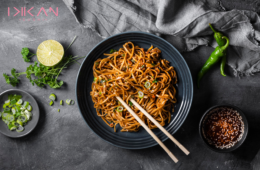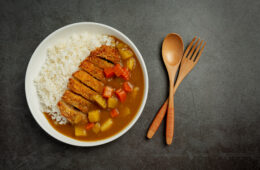
When you think about it, food has always been more than just something we eat. It’s a way cultures pass down their stories — bits of history, tradition, and identity, all packed into a single dish. It’s honestly pretty incredible how just one meal can give you a glimpse into an entire way of life. Take sushi, for example.
It’s not just a famous dish from Japan but a real piece of history. Sushi actually started more than a thousand years ago, and it wasn’t anything like the fancy rolls we see today. Back then, it was just a clever way to preserve fish. Over time, though, it grew into this beautiful, delicate art form that people all over the world have fallen in love with.
Today, sushi stands right up there with anime & manga as one of the country’s biggest cultural exports to the world. Maybe it’s the clean flavours, maybe it’s the simple elegance, or maybe it’s the way every piece feels like it has a story behind it. Whatever it is, sushi has a way of winning people over everywhere.
In this blog, we’re going to dig into what sushi really is, what it tastes like, and why it means so much — not just in Japan, but around the world.

But What Even Is Sushi, Really?
So, quick reality check — sushi doesn’t mean raw fish.
I know, I know, that’s what pretty much everyone thinks at first. But nope. It’s actually about the rice. The vinegared rice. That’s the real star. Everything else — the fish, the veggies, even the egg — that’s just what you put on top of it or roll into it.
And there’s not just one kind either. At sushi restaurants in London & beyond, you’ve got nigiri (the little hand-pressed ones with a slice of fish), maki (the classic rolls you probably picture first), sashimi (which, side note, isn’t even technically sushi because there’s no rice). Then there’s temaki — you know, the hand-rolled cones — and chirashi bowls, which are basically like a sushi deconstructed and dumped in a bowl (but in a good way).
But at the heart of it? It’s simple. It’s about getting a few perfect ingredients and letting them shine. No heavy sauces, no drowning in spice — just balance. Clean flavours. Texture. Presentation. Every little thing is thought through. Even the spaces between flavours. That’s sushi.
So, What Does Sushi Taste Like?
Honestly? Sushi tastes like… clarity. It’s clean. Light. It’s not trying to overpower you — it’s just letting you taste everything, properly.
The rice gives you this soft, slightly tangy base (thanks to the vinegar), and the fish — whether it’s raw or cooked — brings in that rich, savory, almost ocean-kissed flavour. Then you’ve got soy sauce if you want a salty punch. Wasabi for a little burn (careful, it sneaks up on you). And pickled ginger — not just decoration — it’s meant to reset your mouth between bites. Like a palate reset button.
Texture’s a big deal too. Bigger than you think. Soft rice, silky fish, a little chew from the seaweed, maybe some crunch if there’s cucumber or tempura involved. It’s this whole quiet party of textures happening with every bite.
And not all sushi tastes the same either. Some are so delicate you almost have to pause to catch the flavours. Others — like a spicy tuna roll or rich eel nigiri — hit harder, with smoky, sweet, or spicy kicks. But even the bold ones never lose that sushi vibe — fresh, elegant, clean.
It’s the kind of food that leaves you feeling… lighter. Like you ate something real.
How Sushi Took Over the World (and Why We’re All Obsessed)
It’s wild to think about, but sushi isn’t just a Japanese thing anymore — it’s everywhere.
Walk down a street in New York, London, Sydney… odds are, you’ll bump into a sushi restaurant without even trying. And it’s not just the traditional stuff either. You’ll find everything from melt-in-your-mouth nigiri to wild fusion creations that probably have your favorite snack rolled inside. (Sushi burritos, anyone?)
How Sushi Became a Global Superstar
Sushi didn’t just sneak into the world’s heart by accident. It’s deeply tied to what makes Japanese culture so magnetic — the simplicity, the quiet elegance, the deep, almost spiritual respect for nature and balance.
There’s something about that clean, thoughtful approach that just clicks with people everywhere. In a world that often feels loud and cluttered, sushi feels like breathing fresh air. No wonder it caught on.
Sushi’s Cool Factor (Yeah, It’s a Thing)
Sushi didn’t just stay on the plate — it jumped straight into pop culture.
You’ll spot it in movies, TV shows, slick ad campaigns. It’s become a bit of a vibe — sleek, stylish, effortless. Somewhere along the way, eating sushi became shorthand for having good taste. (Literally and figuratively.)
How the World Put Its Own Spin on Sushi
One of the coolest things about sushi’s global takeover? Everywhere it goes, it picks up little local twists.
When looking for sushi restaurants in London, for example, you’ll find places offering California rolls, sushi burritos, spicy mayo everything. Purists might clutch their pearls, but honestly? That creativity just shows how much people love sushi. They can’t help but make it their own.
Sushi in London (Yes!)
Especially here, people there love their sushi in London. Just try searching “sushi near me” in London and watch your map light up. From high-end omakase experiences to cozy little spots tucked in side streets, sushi’s got a home everywhere.
And whether you’re on a budget or ready to splurge, there’s a sushi place for you. Fancy a quick bite? Need an elegant dinner spot? Sushi’s got you covered. Better yet, try us for the best sushi in Marylebone!

Sushi and Japan’s Soul: Why It’s So Much More Than Food
At its core, sushi isn’t just something you eat — it’s something you experience.
It’s the product of serious craftsmanship. Like, serious — we’re talking chefs who spend years just learning how to properly cook rice before they even touch the fish.
That obsession with detail? That total commitment to getting it just right?
That’s Japan’s cultural heartbeat. Respect for ingredients. Pride in doing things well. Deep connection to nature. Sushi’s a living, breathing piece of that spirit.
Minimalism on a Plate
Simplicity is everything in sushi. It’s never about loading a dish with a million things. It’s about picking a few perfect ingredients and making them sing. Every slice, every grain of rice matters.
And when you eat it, you feel it — that quiet beauty of something that’s both simple and absolutely flawless.
Sushi’s Love Letter to Nature
Sushi’s whole existence is a nod to nature. It’s built around what the seasons give. Different fish, different flavors — everything changes depending on what’s freshest, what’s natural right now.
It’s not about forcing flavors. It’s about listening. Letting nature lead. That respect runs deep through every bite.
The Masters Behind the Magic: Sushi Chefs
Sushi chefs — or itamae — aren’t just making food. They’re creating little moments. Moments where technique meets artistry meets soul.
In Japan, these chefs are revered. Rightfully so. Watching a true itamae work is like watching a dancer or an artist — precise, graceful, totally focused. They don’t just feed you. They share something with you.
Sushi: More Than Just Dinner — It’s Japan in Bite-Sized Form
Along with anime and manga, sushi’s one of Japan’s greatest gifts to the world. And honestly, it’s not just about eating raw fish or fancy rolls. It’s about tasting the values that built a whole culture — seasonality, craftsmanship, beauty in simplicity.
How to Actually Enjoy Sushi (Without Looking Clueless)
Okay, if you’re new to sushi (or even if you’re not), there are a few unspoken rules that can make your experience way better.
1. Go Easy on the Soy Sauce
You do not need to drown your sushi in soy sauce. Just a gentle dip on the fish side (not the rice) is plenty. The rice is already seasoned, and too much soy sauce will just wipe out all those delicate flavours.
2. It’s Totally Fine to Use Your Hands
Especially for nigiri — picking it up with your hands is actually more traditional. Plus, it’s easier to keep everything intact when you eat it in one bite.
3. Handle Wasabi with Caution
A little goes a long way. Seriously. Wasabi is not to be treated like guacamole. Add a dab if you like a kick, but don’t go overboard unless you’re ready to tear up in public.
4. Mix It Up
Searching for “sushi near me”? Don’t just order the same spicy tuna roll every time. Try nigiri. Try sashimi. Try something weird and seasonal you’ve never heard of. Part of the magic of sushi is how different everything can taste and feel.
Why Sushi’s Actually Super Good for You
As if tasting amazing wasn’t enough, sushi’s also sneakily healthy. Here’s why:
Packed with Omega-3s
Fatty fish like salmon and tuna are loaded with omega-3 fatty acids, which are incredible for your heart and brain.
High in Protein
Especially if you’re going heavy on nigiri and sashimi, you’re getting lean, clean protein.
Light on Calories
A few pieces of sushi make a surprisingly light meal, but they’re still really satisfying.
Nutrient-Rich
Seaweed, veggies, fish — they all bring a ton of essential vitamins and minerals to the table.
Good for Your Gut
Seaweed’s packed with fiber, and that rice vinegar? It helps with digestion. So even your stomach will thank you.
If You’re in London, Here’s Where You Need to Go
If you’re looking for the best sushi restaurant nearby in London, especially getting the best sushi in Marylebone and around, you have to check us out at Ikkan Sushi. As one of the best sushi restaurants in London, we know how to nail that perfect balance between tradition and innovation. Fresh ingredients. Skilled chefs. An atmosphere that feels welcoming but special.
Whether you’re new to sushi or basically live on it, Iikan Sushi is the real deal. Go treat yourself. You’ll be thinking about it for days!
Frequently Ask Questions
What is sushi made of?
Ans. Sushi consists of vinegared rice, fresh fish, and vegetables, often wrapped in seaweed. There are various types, including nigiri, maki, and sashimi.
What does sushi taste like?
Ans. Sushi has a clean, delicate flavour that combines the natural taste of fish with the slight tanginess of rice vinegar. The soy sauce adds saltiness, while wasabi adds a sharp kick.
Is sushi healthy?
Ans. Yes, sushi can be a healthy choice, as it’s packed with lean protein, omega-3 fatty acids, and essential nutrients. It’s low in calories and rich in vitamins.
How should I eat sushi?
Ans. It’s common to eat sushi with your hands, especially nigiri. Use soy sauce sparingly, and don’t forget to enjoy the balance of fresh flavours with each bite.
What makes sushi such a popular dish worldwide?
Ans. Sushi’s popularity is due to its unique combination of fresh ingredients, beautiful presentation, and a deep cultural connection to Japanese tradition. It’s also versatile and can be adapted to local tastes.






